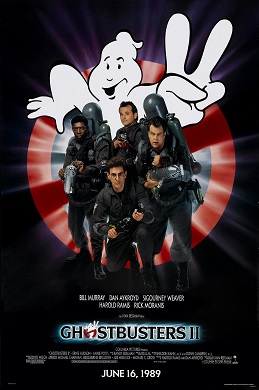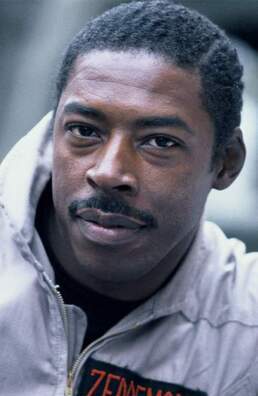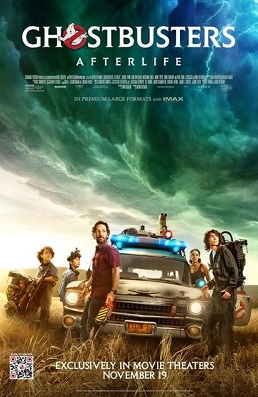
Ghostbusters is a 1984 American supernatural comedy film directed by Ivan Reitman and written by Dan Aykroyd and Harold Ramis. It stars Bill Murray, Aykroyd, and Ramis as Peter Venkman, Ray Stantz, and Egon Spengler, three eccentric parapsychologists who start a ghost-catching business in New York City. It also stars Sigourney Weaver and Rick Moranis, and features Annie Potts, Ernie Hudson, and William Atherton in supporting roles.

Ghostbusters II is a 1989 American supernatural comedy film directed by Ivan Reitman and written by Dan Aykroyd and Harold Ramis. The film stars Bill Murray, Aykroyd, Sigourney Weaver, Ramis, Rick Moranis, Ernie Hudson, and Annie Potts. It is the sequel to the 1984 film Ghostbusters and the second film in the Ghostbusters franchise. Set five years after the events of the first film, the Ghostbusters have been sued and put out of business after the destruction caused during their battle with the deity Gozer the Gozerian. When a new paranormal threat emerges, the Ghostbusters reunite to combat it and save the world.

Extreme Ghostbusters is an American animated television series, based on the Ghostbusters franchise, which initially aired from September 1 to December 8, 1997. A sequel to The Real Ghostbusters, which aired from 1986 to 1991 on ABC, Extreme Ghostbusters is set after that series' finale. The 40-episode series initially aired on the syndicated Bohbot Kids Network's "Extreme Block" in 1997, and featured a team of college-aged Ghostbusters led by veteran Ghostbuster Egon Spengler. In some TV listings, the series was called Ghostbusters Dark.

The Ecto-1 is a fictional vehicle from the Ghostbusters franchise. It appears in the films Ghostbusters (1984), Ghostbusters II (1989), Ghostbusters (2016), Ghostbusters: Afterlife (2021), Ghostbusters: Frozen Empire (2024), in the animated television series: The Real Ghostbusters and Extreme Ghostbusters, and in the video games Ghostbusters: The Video Game and Ghostbusters: Spirits Unleashed.

The Stay-Puft Marshmallow Man is a fictional character from the Ghostbusters franchise, who sometimes appears as a giant, lumbering, and paranormal monster. He first appears in the 1984 Ghostbusters film as a logo on a bag of marshmallows in Dana Barrett's apartment, on an advertisement on a building near the Ghostbusters' headquarters, and finally as the physical manifestation and form of the apocalyptic Sumerian deity Gozer.

Peter Venkman, PhD is a fictional character from the Ghostbusters franchise. He appears in the films Ghostbusters, Ghostbusters II, Ghostbusters: Afterlife, Ghostbusters: Frozen Empire and in the animated television series The Real Ghostbusters and Extreme Ghostbusters. In those four live action films, he was portrayed by Bill Murray, and was voiced in the animated series first by Lorenzo Music and then by Dave Coulier. Dan Aykroyd originally wrote the script with John Belushi in mind to play the role of Venkman but Belushi died of a drug overdose on March 5, 1982, leading Murray to get the role. Venkman is a parapsychologist, initially a skeptic on the paranormal despite being a scientist on the subject, and the leader of the Ghostbusters.

Raymond Stantz, PhD, is a fictional character from the Ghostbusters franchise. He appears in the films Ghostbusters (1984), Ghostbusters II (1989), Casper, Ghostbusters: Afterlife (2021) and Ghostbusters: Frozen Empire (2024), the animated television series The Real Ghostbusters and Extreme Ghostbusters, and the video games Beeline's Ghostbusters, Ghostbusters: The Video Game (2009), Planet Coaster (2019), Ghostbusters: Spirits Unleashed (2022) and Ghostbusters: Rise of the Ghost Lord (2024). He was portrayed by Dan Aykroyd in five live action films, and voiced by Frank Welker in the animated series. He is a member of the Ghostbusters and one of the three Columbia University professors of parapsychology, along with Dr. Peter Venkman and Dr. Egon Spengler.

Egon Spengler, PhD is a fictional character from the Ghostbusters franchise. He appears in the films Ghostbusters, Ghostbusters II, and Ghostbusters: Afterlife, in the animated television series The Real Ghostbusters and Extreme Ghostbusters, and in the video games Ghostbusters: The Video Game and Ghostbusters Beeline. Egon was portrayed by Harold Ramis in the films and voiced by him in Ghostbusters: The Video Game and Lego Dimensions, and voiced by Maurice LaMarche in the cartoon series. He is a member of the Ghostbusters and one of the three doctors of parapsychology, along with Dr. Peter Venkman and Dr. Ray Stantz.

Janine Melnitz is a fictional character in the Ghostbusters series. She is the Ghostbusters' secretary and confidante and occasionally, a ghostbuster herself. She was played by Annie Potts in the first two movies, and in The Real Ghostbusters, she was voiced initially by Laura Summer and later on by Kath Soucie. In Extreme Ghostbusters, she was voiced by Pat Musick. Potts reprised the role for 2009's Ghostbusters: The Video Game, 2021's Ghostbusters: Afterlife and 2024's Ghostbusters: Frozen Empire and had a cameo as a similar hotel receptionist in the 2016 remake.

Winston Zeddemore, PhD is a fictional character appearing in the Ghostbusters films, TV series, and video games. He is played by Ernie Hudson in the films Ghostbusters, Ghostbusters II, Ghostbusters: Afterlife and Ghostbusters: Frozen Empire and was voiced by Arsenio Hall in the first three seasons of The Real Ghostbusters. Buster Jones provided Winston's voice in the remaining seasons, and he reprised the role in a cameo on Extreme Ghostbusters. Hudson returned to provide his appearance and voice to Zeddemore in 2009's Ghostbusters: The Video Game and 2022's Ghostbusters: Spirits Unleashed.

Slimer, originally referred to as "Onionhead" and sometimes "the Mean Green Ghost" and "Ugly Little Spud", is a character from the Ghostbusters franchise. He appears in the films Ghostbusters (1984), Ghostbusters II (1989), the remake Ghostbusters (2016), and Ghostbusters: Frozen Empire (2024), in the animated television series: The Real Ghostbusters, Slimer! and Extreme Ghostbusters, and in the video games: Ghostbusters: The Video Game (2009), Beeline's Ghostbusters (2013), Ghostbusters: Spirits Unleashed (2022) and Ghostbusters: Rise of the Ghost Lord (2024). Slimer was voiced by Ivan Reitman and Adam Ray in the films and by Frank Welker in the animated series. In The Real Ghostbusters, he is the Ghostbusters' mascot and friend.

Ghostbusters: Legion is a 2004 comic book mini-series published by the Quebec-based publisher, 88MPH Studios run by Canadian Sebastien Clavet. It was written by Andrew Dabb, with pencils by Steve Kurth and inks by Serge LaPointe. The series ran 4 issues from February through May 2004. It was collected as a hardcover collection in 2005 by 88MPH and was supposed to be released via a Diamond Comic Distributors "Previews" exclusive. However, the hardcover never came to pass due to the company's financial problems. It was reprinted as a softcover trade paperback that year, for the UK market by the British Titan Books.

55 Central Park West is a 19-floor housing cooperative on the Upper West Side of Manhattan in New York City. Built in 1929, it was designed by the architectural firm Schwartz & Gross. The building is a contributing property within the Central Park West Historic District, which is listed on the National Register of Historic Places.
The Ghostbusters franchise consists of American supernatural comedies, based on an original concept created by Dan Aykroyd and Harold Ramis in 1984. The plot ostensibly centers around a group of eccentric New York City parapsychologists who investigate, encounter, and capture ghosts, paranormal manifestations, demigods and demons. The franchise expanded with licensed action figures, books, comic books, video games, television series, theme park attractions, and other original Ghostbusters-themed products.

Ghostbusters: The Video Game is a 2009 action-adventure game based on the Ghostbusters media franchise. Terminal Reality developed the Windows, PlayStation 3, and Xbox 360 versions, while Red Fly Studio developed the PlayStation 2, PlayStation Portable, and Wii versions. The game was released after several delays in development and multiple publisher changes. In North America, all versions of the game were published by Atari Interactive, while in Europe, the PlayStation 2, PlayStation Portable, and PlayStation 3 versions were published by Sony Computer Entertainment Europe. A separate game for the Nintendo DS with the same title was developed by Zen Studios and released at the same time, albeit with substantial differences in the gameplay and story.

Ghostbusters: Afterlife is a 2021 American supernatural comedy film directed by Jason Reitman from a screenplay he co-wrote with Gil Kenan. It is the sequel to Ghostbusters (1984) and Ghostbusters II (1989), and the fourth film in the Ghostbusters franchise. The film stars Carrie Coon, Finn Wolfhard, Mckenna Grace, and Paul Rudd, alongside Bill Murray, Dan Aykroyd, Ernie Hudson, Annie Potts, and Sigourney Weaver reprising their characters from the earlier films. Set 32 years after the events of Ghostbusters II, it follows a single mother and her children who move to an Oklahoma farm they inherited from her estranged father Egon Spengler, a member of the original Ghostbusters.
Lego Ghostbusters is a Lego theme based on the Ghostbusters franchise created by Dan Aykroyd and Harold Ramis. It is licensed from Columbia Pictures and Ghost Corps. The Lego Ghostbusters theme was first introduced in 2014. The first set was released in June 2014 as part of the Lego Ideas theme. Later, a set based on the Ghostbusters' firehouse was released and one set based on the Ghostbusters: Answer the Call. The Lego Group also used this license for character and level packs in the Lego Dimensions toys-to-life video game. In 2018, a set was released as part of the Lego BrickHeadz theme. In 2020, another set was released in November 2020 and based on Ghostbusters: Afterlife film.

Ghostbusters: Spirits Unleashed is a 2022 action game by IllFonic. An asymmetrical multiplayer game based on the Ghostbusters media franchise, it is set after the events of Ghostbusters: Afterlife and focuses on players tackling matches either as a ghostbuster trying to capture ghosts, or a ghost trying to haunt a location. It was released for Microsoft Windows, PlayStation 4, PlayStation 5, Xbox One and Xbox Series X/S in October 2022. A Nintendo Switch port was released on October 19, 2023.

















